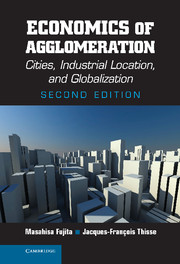Book contents
- Frontmatter
- Dedication
- Contents
- Acknowledgments
- Preface to the Second Edition
- 1 Agglomeration and Economic Theory
- Part I Fundamentals of Spatial Economics
- Part II The Structure of Metropolitan Areas
- Part III Factor Mobility and Industrial Location
- Part IV Urban Systems, Regional Growth, and the Multinationalization of Firms
- References
- Author Index
- Subject Index
1 - Agglomeration and Economic Theory
Published online by Cambridge University Press: 05 August 2013
- Frontmatter
- Dedication
- Contents
- Acknowledgments
- Preface to the Second Edition
- 1 Agglomeration and Economic Theory
- Part I Fundamentals of Spatial Economics
- Part II The Structure of Metropolitan Areas
- Part III Factor Mobility and Industrial Location
- Part IV Urban Systems, Regional Growth, and the Multinationalization of Firms
- References
- Author Index
- Subject Index
Summary
INTRODUCTION
This book is an attempt to uncover the main economic reasons for the existence of peaks and troughs in the spatial distributions of population and wealth. Economic activities are not concentrated on the head of a pin, nor are they spread evenly over a featureless plain. On the contrary, they are distributed very unequally across locations, regions, and countries, generating contour lines that vary with time and place. Just as matter in the solar system is concentrated in a small number of bodies (the planets and their satellites), economic life is concentrated in a fairly limited number of human settlements. Furthermore, paralleling large and small planets, there are large and small settlements with very different combinations of firms and households. Though universal, these phenomena are still in search of a general theory.
The common belief, however, is that we now live in a world where the tyranny of distance, which has been such a powerful force in human history, no longer exists. The spectacular and steady drop in transport costs since the mid-nineteenth century, compounded by the decline of protectionism and, more recently, by the near disappearance of communication costs, is said to have freed economic agents from the need to be located near one another, suggesting that our economies are entering an age that will culminate in the “death of distance.” If so, locational difference would gradually fade because agglomeration forces would vanish. In other words, the combined impact of technology and globalization would make the traditional geography of economic activity obsolete and yesterday’s world of peaks and troughs would miraculously become “flat.”
- Type
- Chapter
- Information
- Economics of AgglomerationCities, Industrial Location, and Globalization, pp. 1 - 26Publisher: Cambridge University PressPrint publication year: 2013
- 3
- Cited by



